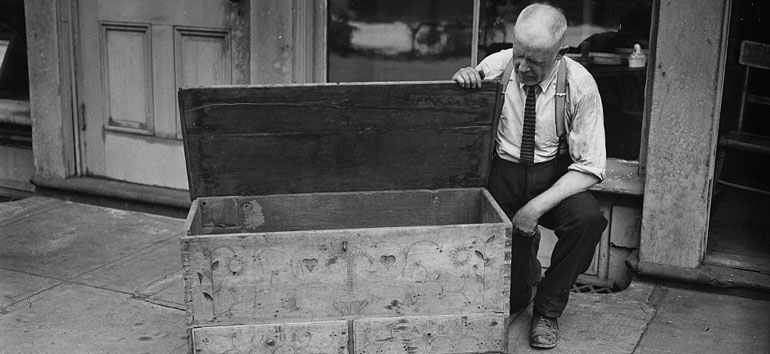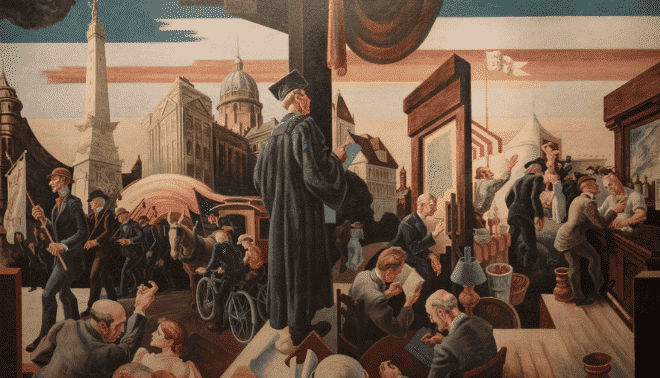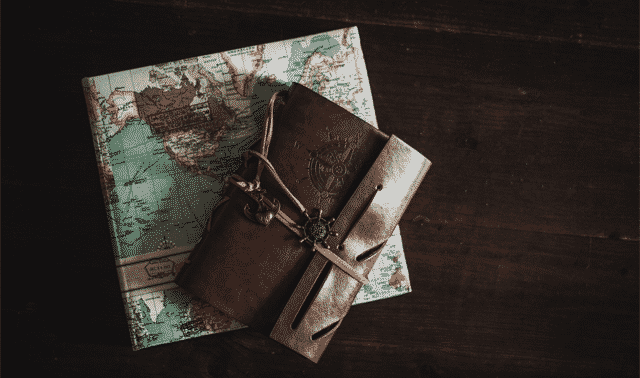Sign up for the Family Tree Newsletter! Plus, you’ll receive our 10 Essential Genealogy Research Forms PDF as a special thank you.
Get Your Free Genealogy Forms
"*" indicates required fields

When genealogists think of buried treasure, most don’t picture a creaky wooden chest full of shiny gold coins. Instead, caches of photos, newspapers and records often come to mind—the kinds of things that might be hidden inside a time capsule. These blasts from the past hold treasures someone carefully selected to represent themselves and their times, and then stowed away for an unknown future person to find.
There’s actually a society that keeps track of these genealogical collections: the International Time Capsule Society, hosted at Oglethorpe University in Georgia. The group oversees “the father of the modern time capsule,” the strangely curious Crypt of Civilization. The 20-by-10-foot underground room, designed to hold records for 6,000 years, is filled with documents, photos and artifacts of modern civilization.
The chamber’s stainless steel door was welded shut in May 1940, to be reopened in the year 8113. Visitors can gaze upon the door. Nobody alive now will be around for that unveiling (I’m imagining copies of the 1890 census in there), but on these pages, you can bear witness to the opening of other famous time capsules and their curious contents. Here’s a look at seven of these blasts from the past.
ADVERTISEMENT
1. Revere Reveal: 1795–2014
A copper box filled with colonial artifacts selected in 1795 by none other than Paul Revere and Samuel Adams is widely accepted as the oldest American time capsule. The box was laid beneath the cornerstone of Boston’s State House on July 4, 1795, as the site was dedicated.
The box doesn’t fit the technical definition of a “time capsule” because no one set a specific date to open it. Rather, it would be called a foundation or cornerstone deposit, according to International Time Capsule Society founders William E. Jarvis and Knute Berger. Burying ceremonial artifacts in building foundations has a long and noble history, dating back to holy relics placed within the floors and walls of medieval cathedrals.
Revere’s and Adams’ foundation deposit box was rediscovered twice. First, in 1855, workers adding on to the state house unearthed the box. Someone added new items before resealing the brass box in plaster and replacing it. In December 2014, workers fixing a water leak found it again. Curators from the Museum of Fine Arts in Boston carefully opened the container to reveal 17th-century coins, an intact newspaper (an 1855 edition), a medal bearing George Washington’s likeness and a silver plaque engraved by Revere. You can view videos of the contents at the museum website.
ADVERTISEMENT
Six months later, conservators transferred the contents to a stainless steel container, added a 2015 mint coin set and a new plaque, and filled the box with argon gas. It’s again inside the building’s foundation, awaiting its next rediscovery.
2. The Safe Side: 1876–1976
By Jarvis’ definition, the earliest “official” American time capsule was the Century Safe, exhibited at the 1876 Philadelphia World’s Fair. A woman named Anna Diehm, publisher of the Our Second Century weekly, had the idea and assembled the contents in a fireproof cabinet. President Ulysses S. Grant observed the ceremonial closing. The case was stored at the US Capitol, designated for opening at the nation’s bicentennial in 1976.
President Gerald Ford and Congressional leaders witnessed the Century Safe opening. Out came a scroll signed by members of the 44th Congress, an album with autographs of other prominent men, a gold pen from poet Henry Wadsworth Longfellow and photos by photographer Matthew Brady. Diehm’s concept of a preservation safe led the way for future vaults and a time capsule craze that swept the nation.
3. Near Miss: 1894–2015
Astronomer and optical instrument maker John Brashear’s 1894 foundation deposit was nearly destroyed a few years ago during the demolition of the building that once housed his business in Pittsburgh’s Observatory Hill district.
Brashear had placed a small metal box in the cornerstone of the Astronomical & Physical Instrument Works on Aug. 14, 1894. In 2015, conservators at the city’s Heinz History Center unpacked and cataloged pictures of Brashear, his wife, Phoebe (labeled “my dear girl”), his employees and his equipment; a lock of Phoebe’s hair; business correspondence; and a small piece of glass labeled “One of the first pieces of optical glass made in America. May we hope that when this stone is opened America will lead the world.” The contents are personal; you get the impression that Brashear carefully selected each item. Although the box doesn’t specify an opening date, Brashear, like Revere, clearly intended the box to be opened at some future point.
Brashear’s time capsule is now at the Heinz History Center. You can read about it and see photos of the contents on the center’s blog.
4. Touching Base: 1913–2017
After the New Orleans city government removed a statue of Confederate Gen. P.G.T. Beauregard in 2017, workers found a time capsule beneath the pedestal. The badly oxidized copper box had been placed Nov. 14, 1913, during a dedication ceremony. The contents were waterlogged, some damaged beyond recognition.
A list of the relics was read aloud at the 1913 ceremony, and the New Orleans Times Democrat described them the next day. They included:
- the ceremony invitation and program
- Beauregard Monument Association charter and member list
- the Confederate States seal
- the four Confederate flags and a US flag
- photos of Confederate monuments to Gen. Robert E. Lee, Jefferson Davis and others
- badges of Confederate organizations
- several newspapers
- Confederate and Louisiana currency
- a city guide to New Orleans
- Chaudron’s spelling book from 1865
Many time capsules are lost over time, according to the Oglethorpe University Time Capsule Association. Theft and secret locations that die with the owner are sometimes responsible. But containers and placements vulnerable to the elements also account for damaged contents. The contents of the Beauregard time capsule were subject to changes in temperature and humidity, and the effect of interaction among items inside. After conservation, the items may go on display at the Louisiana State Museum.
5. About Scouts: 1961–2010
The Boy Scouts of Troop 11 in Wiesbaden, Germany, assembled a time capsule to commemorate the 50th Anniversary of Scouting in 1961. German and American troop members contributed photos, film, newspapers, scouting books, and letters from US government leaders. It was to be opened on the 100th birthday of the Boy Scouts in 2010. The container was placed at the US Military’s General von Steuben Hotel in Wiesbaden. (The hotel famously played host to President John F. Kennedy on his way to Berlin in 1963.)
Today the hotel is called the Dorint Pallas Wiesbaden, and its conscientious engineering department kept track of the capsule’s whereabouts and the countdown to opening day. On May 8, 2010, scouts who created the time capsule were among those present to open it, along with current scouts and the mayor of Wiesbaden.
6. Scrunchies and Cookies: 1987–2012
A time capsule doesn’t have to be filled with historically significant artifacts. Personal objects of everyday life capture personalities and a point in time—fascinating for anyone interested in social and cultural history. Case in point: In 1987, Girl Scout Troop 272 of Brea, Calif., buried a memory-filled steel box. Members marked the location with a bronze plaque engraved with the reopening date, the 100th anniversary of Girl Scouting.
The scouts gathered 25 years later to open the treasury of 1980s life: a “Happy 100th” birthday balloon, teen fan magazines, campfire ashes, hair scrunchies, a scrapbook about then-current events, and a green Thin Mints box (empty, of course—who could wait 25 years to eat them?).
7. Car Wreck: 1957–2007
In 1957, Tulsa, Okla., residents were looking for a memorable state jubilee project that would truly set their city apart. They settled on a time capsule to be buried in a Plymouth Belvedere two-door sedan and scheduled for disinterment after 50 years. A contest had locals predict the city’s 2007 population; the lucky heir of the person who came closest would win the car and a $100 savings bond.
The car was sprayed with a preservative, wrapped in plastic and set in a concrete vault. Road trip supplies filled the trunk: gasoline, oil and beer. The glove compartment held hairpins, a makeup compact, plastic rain cap, comb, chewing gum, cigarettes, a bottle of tranquilizers, $2.73 in cash and unpaid parking tickets.
Unfortunately, the vehicle wasn’t quite in driving condition. The burial location in downtown Tulsa had caused some worry about road vibrations that might crack the concrete vault. Those fears were realized when the car was found sitting in four feet of water in 2007. The unveiling at the city convention center revealed a sea of mud and rust that had damaged the artifacts inside, although the chrome still shone brightly when the front bumper was cleaned.
A metal time capsule cylinder welded to the car’s roof fared better, with its contents in near-perfect condition: a US flag, letters from city officials, and the contest guesses. Raymond E. Humbertson’s prediction of 384,743, was closest to the Census Bureau’s stat of 382,457. He had passed away, so his sister received the car. After a superhuman rust removal effort, it was sent to an auto museum in Roscoe, Ill.
A version of this article appeared in the January/February 2019 issue of Family Tree Magazine
Related Reads
ADVERTISEMENT




